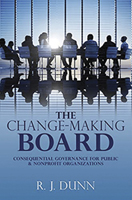
The Change-Making Board: Consequential Governance for Public & Nonprofit Organizations
by Randy J. Dunn, Mill City Press, Maitland, Fla., 2021, 228 pp. with index, $17.49 softcover
Author Randy J. Dunn has had deep experience with boards over his 38-year career, both reporting to boards and being on boards. He served as state superintendent for Illinois and as a public university president in three states. While his history gives him perspective, it is unfortunate that he does not spice up the narrative with examples of what he has endured firsthand and how he and his organization have emerged. Nevertheless, this book is packed with concrete tools about boardsmanship.
The prime audience for this document is neophyte board members on any type of professional or nonprofit board. Chief executive officers or superintendents are secondary parties of interest. One way to digest and use his advice would be to have copies for each board member to read using a “book club” approach with a consultant leading discussions to ensure sufficient comprehension and appreciation for the contents.
Dunn’s basic belief is society needs boards that adopt a learning approach, as circumstances are always going to be in flux over the course of board members’ service. He seems to be suggesting organizational transformation starts with board members comprehending how their board must change.
This author builds off the foundation of a model designed by Terry Deal and Lee Bohman. Their system is called the Four Frame Model of Organizations drawing from psychology, sociology, anthropology and political science. The author and the originators of this design believe organizations can be analyzed through four frames with these metaphors: structural (factories or machines), human resources (families), political (jungles) and symbolic (temples or theaters). An elaboration of these ideas comprises the largest number of pages herein.
According to the author: “In the final analysis what change-making boards and trustees do is think and act long-term-identifying and assessing all forces and influences in their organization’s ecosystem, translating those into meaningful policies and actions, and evaluating how effectively the organization is meeting its mission, fulfilling its purpose, and living according to its values.”
Having worked for many boards and served on over 60 boards, this reviewer has never seen a board that felt the organization’s problems were the board itself, even though numerous others put the blame on the board. Consequently, what is missing in this book is how to get the board to accept the idea that the board must change for the organization to prosper. This deficiency can be weighed against all the practical and traditional advice and techniques offered for the reader which make it worthwhile reading.
Reviewed by Art Stellar, AASA emeritus member, Hingham, Mass.
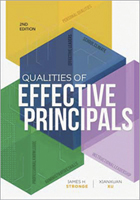 Qualities of Effective Principals, 2nd Edition
Qualities of Effective Principals, 2nd Edition
by James H. Stronge and Xianxuan Xu, ASCD, Alexandria, Va., 2021, 315 pp. with index, $36.95 softcover
Qualities of Effective Principals contains eight chapters highlighting the qualities needed to be a successful principal. These include instructional leadership, school climate, teacher evaluation, organizational management, and communication with "Tools You Can Use" at the end of the book to help identify strengths and areas for improvement.
James Stronge has a consulting company that focuses on teacher and leader effectiveness and serves as a faculty member at the College of William and Mary. Xianxuan Xu is a research associate for the College of William and Mary.
Superintendents and principals can use this book as a study guide for professional learning and leadership improvement at the school level. The "Tools You Can Use" section contains a checklist of best practices to look for in each of the eight chapters and a checklist of red flags. The book also includes research findings and statistics after key points in each chapter.
While the authors overemphasize the curriculum responsibilities of the principal, the chapters are well written and identify the major responsibilities principals should possess to have a successful school in which student learning is the No. 1 responsibility.
One surprising finding was that classroom "walk throughs" have a negative impact on student learning, particularly at the secondary level. The most effective impact on improvement of instruction is the specific feedback and coaching teachers receive after observations.
Also, the authors emphasize the importance of teachers not being in isolation, but having time during the day to interact, plan and collaborate with colleagues. Clear vision, high expectations and a focus on student success are the necessary ingredients for successful schools.
Reviewed by Paul A. Shaw, former director of educator ethics, Georgia Professional Standards Commission, Martin, Ga.
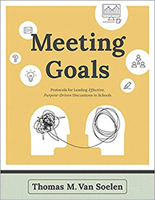 Meeting Goals: Protocols for Leading Effective, Purpose-Driven Discussions in Schools
Meeting Goals: Protocols for Leading Effective, Purpose-Driven Discussions in Schools
by Thomas M. Van Soelen, Solution Tree Press, Bloomington, Ind., 2021, 265 pp. with index, $39.95 softcover
Author Thomas M. Van Soelen provides a wealth of information for both veteran and new educators to facilitate constructive meetings in his book
Meeting Goals: Protocols for Leading Effective, Purpose-Driven Discussions in Schools. The book itself is designed to be a workbook for advancing one’s knowledge in leading effective group discussions and facilitation of team driven outcomes.
Van Soelen relies on expertise as a professional developer and training consultant to provide relevant examples as well as diverse examples relating to a variety of educators he relies on for shared expertise and knowledge. The book is content-rich but provides detailed references and suggests steps to take when implementing the protocols.
Alongside each protocol, the author provides guidance outlined as “language you can borrow” and “application examples.” These tools allow for application of protocols and exemplars. Additional useful guides in the appendices provide tips and tricks at-a-glance for easy use and reminders. The book is full of tools to assist anyone seeking to better themselves in facilitation of dialogue.
Reviewed by Tammy Caraker, administrative director of federal, state and competitive grants, Collier County Public Schools, Naples, Fla.
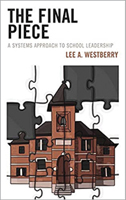 The Final Piece: A Systems Approach to School Leadership
The Final Piece: A Systems Approach to School Leadership
by Lee A. Westberry, Rowman & Littlefield, Lanham, Md., 2020, 134 pp., $50 hardcover, $25 softcover
Schools are complicated and complex systems, where equally complex and complicated subsystems reside within departments, units, specialties and classrooms. Administrators seldom take the time to sit down and contemplate the ways in which all these interactive systems work together to form a cohesive unit.
The Final Piece: A Systems Approach to School Leadership by Lee A. Westberry, a faculty member in educational leadership at The Citadel, provides a look into some of the more common subsystems that exist within the larger school system. Programs, personnel, partners and policies are highlighted, with specific areas receiving focused attention. Student supports systems such as guidance counselors, multitiered systems of support, mentoring programs and outside agencies are considered. The culture system section covers topics related to the school culture system, support and school-community communications.
Templates provided in the book highlight specific ways individualized systems within the larger school have unique and independent parts, but when combined back into the larger view, provide a deal of specificity that allows for their integration within the larger school community.
I am intrigued by the specific systems and subsystems the author chooses to explore. He does an excellent job covering the areas selected, but to me, important subsystems were left out of the discussion. A text that proports to discuss a systems approach would, in my mind, be more inclusive of the larger subsystems and systems that exist within educational organizations. Larger systems include programs and services, and the systems built around them.
For example, food service, transportation, special education would all have specific innerworkings related to their specialties but would also have some larger system requirements that transcend specific functions. In fairness, a tome attempting to address the issues from the totality of systems found in schools would probably run into the tens of thousands of pages.
Even though the author does not cover the same systems and subsystems I would address, I still will recommend this text to my graduate students preparing to become educational leaders. The content areas the book does address provide a look into the complexities of issues that need to be considered when trying to have a more systematic view of a school.
Reviewed by Mark E. Deschaine, associate professor of educational leadership, University of Mississippi, University, Miss.
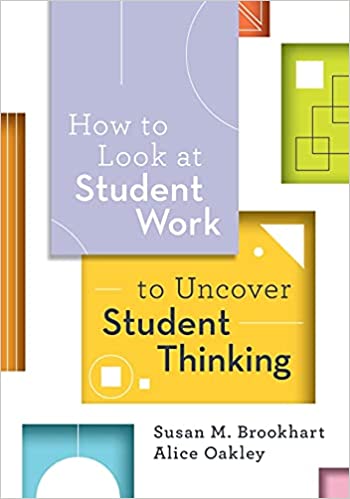 How to Look at Student Work to Uncover Student Thinking
How to Look at Student Work to Uncover Student Thinking
by Susan M. Brookhart and Alice Oakley, ASCD, Alexandria, Va., 2021, 127 pp. with index, $28.95 softcover
Teachers usually assess student work alone. They might be in their classroom after school, at the kitchen table after others are in bed or even sneaking some time at a child’s baseball practice. Grading papers is certainly a necessary function of being a teacher.
Over the past 25 years, a growing movement of researchers and practitioners have identified methods to not just evaluate the accuracy of student work but analyze it: slowing down the process to identify what the student may have been thinking. This analysis, particularly done collaboratively, can yield important next steps for teachers to take with an individual student or groups of students.
In this text, Susan Brookhart has continued her numerous print publications about the formative assessment cycle, including clear learning goals and success criteria. She and co-author Alice Oakley tell the story of teachers who volunteered for a group who consistently met to dig into student work samples.
Ideal for leaders who work directly with teacher teams, the text contains possible processes to use with such teams, whether voluntary or required membership.
Reviewed by Thomas Van Soelen, president, Van Soelen & Associates, Lawrenceville, Ga.
 Dear Black Girl: Letters from your Sisters on Stepping into your Power
Dear Black Girl: Letters from your Sisters on Stepping into your Power
by Tamera Winfrey Harris, Berrett-Koehler Publishers, Inc., Oakland, Calif., 2021, 185 pp. with index, $16.95 softcover
Tamara Winfrey Harris penned
Dear Black Girl with the purpose of affirming and empowering Black girls to be their best selves despite negative narratives and experiences that too often prevail. As a Black woman and former Black girl, the letters from nearly 40 writers were powerful and inspiring.
Letters are divided into categories by chapter beginning with Chapter One, “Black Girl Magic: Identity and Self-Love.” The authors address the readers with terms of endearment like Wonderful Human, Magical Black Girl and Dope Black Girl. The opening chapter makes clear the author intends to reach readers from a varied background. Letters are written specifically to biracial, queer and questioning Black girls.
“You will go through life hearing horror stories and know the pain of losing people simply for being who you are,” one letter says. The same author, Tatiana, ends with encouraging words that remind the reader, “You are carried by giants.”
In Chapter Six, “Black Girl, Interrupted,” mental health is addressed in plain language that speaks to the heart of this difficult topic. Mental health is still seen as taboo in the Black community, but one author, Tyffani, states it best by reassuring the reader, “Your anxiety and depression are real — even if you cannot quite figure what causes them. Your anger — that others call ‘attitude’ is real. Your hopelessness when it feels your community does not value or see you — or that it values Black boys over you — is real.”
Each chapter includes a section titled “Know This.” I appreciated this inclusion as it was a space where terms were defined and clarity with additional details were given to relevant topics addressed. Finally, the chapters ended with a writing prompt for the reader to write a “Letter to My Black Girl Self.” This gives the reader an opportunity to reflect and to journal.
I would recommend this book for anyone interested in understanding more about the experience of being a Black girl. It would be instrumental for small group mentoring and for educators or other professionals who work with girls of color. The author was effective in providing a well-rounded group of contributing letter writers. I would read a sequel and look forward to sharing this book with the Black girls in my life.
Reviewed by Avis Williams, superintendent, Selma, Ala.